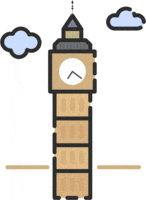Time Math Worksheets
One of the few things that never stops, and we cannot purchase more of is time. We use it to measure and compare the length of events and the gaps between them. This is one of those interesting topics to teach because you are never going where a student stands with the concept until you get there. I am constantly surprised by the skills that students will have this. Some families pride themselves on teaching their children how to measure time on all types of different devices. In this section you will learn how to read clocks and calendars in different increments. The lessons and worksheets will explore the concept of time differences and how to quickly and easily handle them. See if I missed anything in your curriculum. There is very little in the core curriculum about this stuff.
- Calculating Elapsed Time - Learn to determine the amount of time that lapses between two times.
- Days of Week - Students learn the names and order of the days of the week.
- Elapsed Time Using Ruler - This really helps students learn how to read timecards.
- Elapsed Time Word Problems - We put you in situations that allows math to be your superhero.
- Estimating Times - When someone asks you how long something will take, these are the skills that you will need.
- Hours and Half Hours of Time - These worksheets help you determine time to the full hour or half hour.
- Measuring Time in Minutes - Down to the exact minute.
- Measuring Time in Words - We switch from numbers to words.
- Minutes to an Event - How much time until that event is on?
- Telling Time from Analog and Digital Clocks - Learn how to tell the time in both formats.
- Time Differences - This helps you answer how long something will take for certain.
- Time Word Problems - We put you in situations were time is a critical factor.
- Understanding Annual Calendars - Take a look at an entire year and be able to answer questions about your year.
- Understanding Monthly Calendars - A great deal can happen in a month. Tell us what happens in your month.
Tips for Teaching Time

Most of the kids find it challenging to tell time accurately on an analog clock. But it can be made easier by using some tips and tricks. Below we have discussed some of the tricks that can make time telling fun for your kids. We also give you ideas on where to go from there once you get them to master it.
Have a Digital and Analog Clock Present - I have found this to work wonders. In addition to using them both in your lessons, just having them constantly around students really helps it sink in. I will purposely have one or the other have the wrong time and ask students to help me set it properly.
Counting - Counting to 60 is the basic skill that kids need to master before they are able to tell time. Start by having students practice writing the numbers 1 to 60 and practice this regularly. Then have them progress to writing this sequence by 5s, 10s, 15s, 20s, and 30s. This basic little routine will work wonders. Reinforce this exercise until your kid is able to do it without any assistance.
Teaching Progression - I find that it is best to teaching larger time increments and work you way towards minutes. Conceptually students pick it up much faster. Start with hours, then half-hours, then fifteen-minute intervals, and lastly five-minute increments. You can end of with moving to minutes. I also find that students get the concept quicker by reading premade clocks first and then progressing to writing their own hands on the clocks.
Analog Clock - Once your child has learned counting by fives, use an analog clock to build on this concept. The digital clock might be a better instruction or teaching tool; an analog clock is a better choice in understanding the concepts of time. These clocks will test your child’s ability to count by fives. You can also build your analog clocks by using paper plates or get the print outs of analog for practicing telling time.
Paper Clocks - Have students create them with their own two hands from scratch. The only thing they will need is a template to draw from and a brass fastener to place the minute and hour hand on. I find that students take more pride when working with something that they built from scratch.
Personal Time Tracking - Have students track their own schedule to determine what they are doing with their day. I start by modelling this with our school schedule. I then ask them to create a log of what they did after a school day. I show them my lesson planning that I keep an hourly log of, so that they can see that people actually do this to help themselves. Once they have a good understanding of that, we have them track their entire weekend. This is great for having them master the concept of AM and PM.